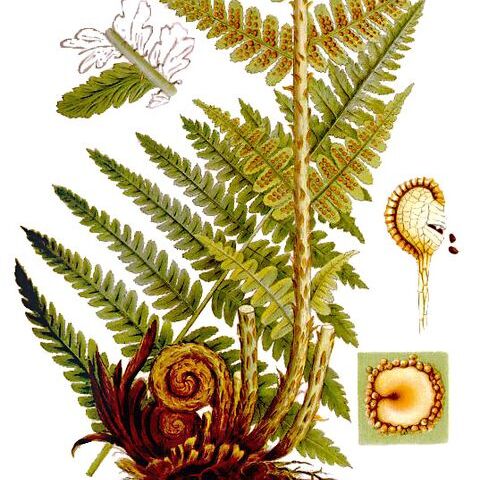Plants terrestrial, rarely on rock. Stems short-creeping to erect, stolons absent. Leaves monomorphic, green through winter or dying back in winter. Petiole ca. 1/4--2/3 blade length, bases swollen or not; vascular bundles more than 3, arranged in an arc, ± round in cross section. Blade deltate-ovate to lanceolate, 1--3-pinnate-pinnatifid, gradually reduced distally to pinnatifid apex, herbaceous to somewhat leathery. Pinnae not articulate to rachis, segment margins entire, crenate, or serrate, spinulose or not; proximal pinnae reduced (several pairs), same size as or enlarged relative to more distal pinnae, sessile to petiolulate, equilateral or often inequilateral with pinnules on basiscopic side longer than those on acroscopic side; costae adaxially grooved, grooves continuous from rachis to costae to costules; indument of linear to ovate scales abaxially, also sometimes with glands, blades ± glabrous adaxially. Veins free, forked. Sori in 1 row between margin and midrib, round; indusia round-reniform, attached at narrow sinus, persistent or caducous. Spores brownish, coarsely rugose or with folded wings. x = 41.
Petiole stout, stramineous or green, with 3–7 free bundles, beset with chaffy scales, especially toward the base; blade pinnate-pinnatifid to tripinnate-pinnatifid, sometimes beset with flattened or hair-like, multicellular scales, otherwise glabrous or merely glandular, the minor axes decurrent on the major ones, the ridges on the upper side of the rachis not raised above the level of insertion of the costae; veins free, mostly ending a little short of the margin in elongate hydathodes; sori roundish, intramarginal (or nearly marginal) on the veins; indusium well developed, persistent, reniform or horseshoe-shaped, glabrous or sometimes glandular; mostly medium-sized to rather large mesophytic ferns with dark green, often evergreen lvs, the rhizomes short, stout, erect or shortly creeping, scaly and commonly covered with old petiole-bases, the lvs tufted, often in a vase-like configuration; x=41, at least for European and temperate American spp. 150, cosmop. Our spp. produce frequent sterile hybrids and also enter into a polyploid complex. The following names are believed to apply to hybrids, as indicated:
Terrestrial, lithophytic or, rarely, epiphytic ferns. Rhizome erect, often arborescent, decumbent or rarely long-creeping; scales entire, fringed, toothed or erose. Fronds tufted or spaced. Stipe scaly. Lamina variable in shape, 1-6-pinnate, chartaceous, often the lowermost pair of pinnae enlarged on the lower side; margins decurrent as lateral wings on the rachises; ridges of the grooves on the adaxial surface of the rachis open to receive the grooves of the minor rachises; veins free. Sori rounded, borne on the veins or at a vein tip; indusium rounded to reniform, often subpeltate, absent in some species. Spores monolete, ellipsoidal.
Terrestrial ferns. Rhizomes erect, very scaly. Fronds (1)-2-3-(6)-pinnate, scaly at least on stipes, often dying down in winter; veins free. Sori round, borne on veins, usually protected by reniform indusia attached centrally. Spores monolete.
Indusium reniform; teeth not so produced

